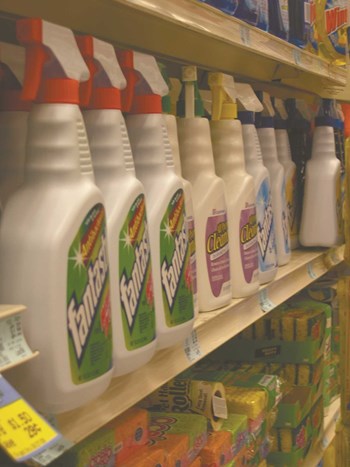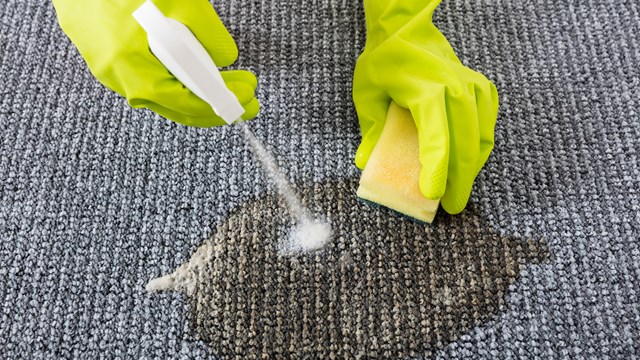
Along with big-ticket items like boilers, HVAC systems, and the like, residential buildings also have to purchase lots of little, everyday things like cleaning supplies, light bulbs, and paper products to keep up with day-to-day maintenance and operations. Though not necessarily expensive in and of themselves, costs for these small things can definitely add up over the course of a year. As the ones charged with ordering and inventorying these supplies, it’s up to managers and building staff members to keep a lid on costs and be conscientious about limiting waste.
Nickels and Dimes
Every time the lights are turned on, dust settles, or somebody tracks some mud into the hallway, supplies are needed. The day-to-day operations of a building will consume products that need to be replaced on an ongoing basis, says Jerry Blumberg of Kew Forest Maintenance Supply in Queens.
“On a daily basis, the list of things residential buildings use include cleaning supplies, carpet cleaning equipment, plumbing supplies, light bulbs, replacement parts…those are your dailies.” He goes on to say that other items such as filters and trash cans will need to be replaced less often, but still must be replenished on a regular basis. In addition, seasonal items such as sidewalk salt, shovels, sand and other season-specific supplies should be considered in the overall picture of necessary purchases in the yearly budget.
According to Ira Meister of Matthew Adam Properties, Inc. in Manhattan, all of these products are purchased out of the maintenance budget, and over the course of a year, the total can add up, especially in larger buildings with more traffic.
“Cleaning supplies and products make up the majority of the supplies budget,” says Meister, “although it’s generally not a large part of the overall budget, except when there is a major repair being done. In that case, especially if the building is doing the repair itself, there will likely be more money spent on these supplies.”
Along with the regular sweeping, mopping, window cleaning, and carpet cleaning, these repairs can generate a great deal of extra dust and other waste. Moreover, repairs that may take several days, weeks, or even months will have a substantial effect on the quantity of cleaning supplies that are consumed.
“Every building may have some unexpected repairs, so they buy extra supplies,” says Syed Haque, an accountant in Queens, specializing in co-ops and condominiums. “Some of the buildings do their own repairs, so that’s when they need some extra supplies.”
Although the types of supplies that are needed and used seasonally may differ, the overall costs throughout the year may not vary as much as might be expected. That said, a wide variety in sizes of buildings and expectations of residents, makes issuing blanket recommendations designed to cut costs difficult, says Blumberg.
“There’s no set system because every building uses different products,” he says. “Years ago, buildings stocked a lot of products. Nowadays it’s often the tenant’s responsibility to do their own maintenance, so buildings don’t stock as much of the plumbing supplies and replacement parts. But they have to stock cleaning supplies because that’s part of the responsibility of the building.”
“I don’t think that you can generalize when buildings spend more money on supplies,” agrees Haque. “It varies from building to building and in different situations. It all varies from month to month.” Wintertime typically sees an increase in snow removal supplies such as salt and shovels, while in the summertime, there is more of a need for supplies related to outdoor activities.
Ordering and Inventory
One benefit of the communal nature of co-op and condo communities is that maintenance and upkeep of the community areas—including the ordering of supplies—is handled on behalf of residents. Keeping necessities on hand without overstocking is largely up to those who are running the building, alleviating the responsibility from the residents, except in their individual units. Still, there are generally tiers of responsibility to make sure that things are being handled as efficiently as possible, says Meister. “The superintendent orders the supplies and the managing agent oversees the process.”
In smaller buildings, and ones with resident do-it-yourselfers, the shareholders might have a more hands-on approach, says Blumberg. In those cases, “it’s the building manager’s responsibility to order and also the tenants, depending on how big the building is.”
Keeping up with supply levels is another important aspect to managing the property. Running out of salt after a snowstorm can result in falls, fines, and lawsuits, and having no place to store excesses can make an awkward journey into the building or a cramped storage area. To avoid these problems, a building’s super or manager (or both) should conduct regular inventory checks to make sure there are neither shortages nor excess supplies. “Inventory should happen on a monthly basis, at least,” says Blumberg.
Most buildings keep closer watch on supply levels, however. “Inventory should be rolling,” says Meister. “There should be a constant eye out for supplies that run low. Conversely, if there is an excess of supplies on hand, that becomes an issue for storage. This isn’t Alaska, or someplace where the truck may only come every couple of months, so keeping too much inventory doesn’t really make sense.”
Bids for Services
In the event of high-dollar operations in a building, such as a renovation or new installation, bids are commonplace and expected. It may not seem like a likely practice, but bids may also be appropriate for large orders of supplies, and can be one way of keeping costs down, says Meister. “Buildings will solicit bids if they are ordering a large amount, and again, if there is a special need, such as a major repair.”
“For regular supplies they don’t ask for bids,” agrees Haque, “but if they’re doing some sort of major repair, then they do ask for a bid. In terms of cleaning supplies, however, [a building] won’t ask for a bid, they will just order the supplies.”
In times gone by, when brand loyalty was considered good business, supplies would be ordered from the same location or company year after year. Times are a-changing, though, and the professionals say that comparison-shopping is becoming more and more commonplace.
“Unfortunately today the loyalty is not there, due to the pricing crisis,” says Blumberg. “Buildings will absolutely shop around for a quote for supplies.” It can really pay to do some homework on the costs of products and how to maximize the needs vs. dollars ratio, saving the building a great deal of money in the long run.
Waste and Theft
Another way to keep costs to a minimum is to monitor how supplies are used and do some investigating when they go missing.
“Theft is not usually a big problem,” says Meister. “Occasionally a bottle of Windex will go missing, but it doesn’t usually become a major issue. Keeping things under lock and key can help.”
On the issue of materials coming up missing or misused, Blumberg agrees: “I would say waste is a much bigger issue than outright theft. It’s not really a problem at all.”
So what can be done about the waste? There are ways to make sure that what’s used is actually what’s needed, says Meister. “Reading the labels on the products themselves will help. People often use a larger portion of soap than they need, for example. These products are often concentrated and may require two ounces, yet half the bottle ends up being used. Supplies are typically ordered in industrial deliveries, and they may come in large containers, so using the correct amount can make a big difference.”
Going Green
With the green movement and energy initiatives in full swing and still gaining momentum, residential buildings have been cited as one of the top two contributors to our carbon emissions problem. Many homeowners, residents, supers, and managing agents have started converting their practices and products to more environmentally sensitive options, but these options are not always money saving at the outset.
“Today, a lot of co-ops and condos are going into green products, green equipment, and green supplies, and yes, they are typically more expensive,” says Blumberg.
Sometimes the costs are made up in the long term, such as compact fluorescent light bulbs that purport to run for nearly a lifetime, while others are on the market with the simple benefit of helping to make our presence in the world more sustainable. For many buildings, that alone is worth the slightly higher ticket price.
Training for Efficiency
Some supply companies offer their customers training in methods of keeping costs down, says Blumberg, and Kew Forest Maintenance Supply is one such company. “When we go into a building to sell cleaning supplies, we do a complete training program either on- or off-site. We also train the client on how to properly use the equipment and the supplies. And if they know how to properly use the equipment, they will save money.”
This training is accessible, too, not just once a year in a remote location…and not offered by only one company. “We train them on-site or in our own classrooms,” says Blumberg, “ and it’s offered anytime. There are a few [companies] who do it. I would say that it’s fairly unique, but not exclusive.”
When it comes to keeping costs down,” Blumberg sums it up simply: “I would place larger orders, fewer times,” he says. That saves the distributors’ shipping costs, which results in giving the customer’s better prices.”
Denton Tarver is a freelance writer and a frequent contributor toThe Cooperator.






Leave a Comment